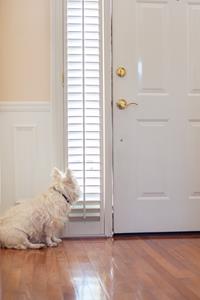Will Your Dog Miss You – or Not?
Dog behaviour experts share tips to support stressed dogs as Canadians return to work
MISSISSAUGA, Ontario, May 23, 2020 (GLOBE NEWSWIRE) -- Canadian families with dogs spending more time at home due to COVID-19 may have noticed their dogs’ behaviour initially changed when people were present 24/7.
“Anyone else’s dog barking like five times more than usual during quarantine?” one person asked on Twitter. “Because I am going to lose my mind.”
Changes in routine can worry dogs and create stress. Coronavirus may have reduced the number of quiet daytime naps, while sleepy streets meant less to bark at. Now, two months later, dogs have finally become at ease with the new routine… just in time to have it change again.
“There will be yet another adjustment for dogs as families slowly return to work,” said Helen Prinold, Chair of the Canadian Association of Professional Dog Trainers (CAPDT) and behaviour consultant at Dog Friendship Training Academy in Guelph, Ontario. Dog experts suggest you start getting back into your work routine now to help prevent problematic boredom and distress from happening.
Key tips include getting back in the work schedule now, even while you are at home. Randomly take a walk without your dog or step out for a few minutes without Fido. Leave a new puppy a crate with a good chew while taking a conference call. Slowly start increasing the time your dog is crated in a separate room, walking back when they are quietly settled to let them out. Slow and gradual changes now can help pave the way to a smooth transition.
Most puppies and dogs are resilient individuals who will easily bounce back from this second change. People with these types of dogs may, however, see an increase in house-soiling (as dogs are not let out on demand) and see more signs of boredom. Fun-seeking can include increases in monotonous barking, destruction of couches (or other chewables) and getting into the garbage. For both these issues, a dog walker may be a good option to help with the transition back to a life with less human presence.
Boredom can also be managed by increasing exercise before going to work and removing what the dog can get into (such as trash cans or food on the counter). Rather than punishing dog behaviour (which serves only to increase stress), trainers recommend using tactics proven to create calm. Leave dogs with low volume classical or light pop music playing in the background, plenty of strong rubber food-filled toys to keep them entertained, and a pheromone diffuser. Local pet stores may also sell anti-anxiety treats. Look for products containing science-backed ingredients like L-theanine, omega-3 fatty acids and milk proteins. Trainers suggest you begin giving food-filled toys and treats at least two weeks prior to your full return to work, so dogs don’t associate them with departures and an empty house.
For dogs with past separation anxiety diagnoses- particularly those whose treatment included medication - now may be a good time to talk with your veterinarian about adding these products back temporarily to help with the transition.
“Just as some people may temporarily miss friends who are not around - while others fall into full-blown depression when social supports are missing,” says Prinold, “dogs can have either temporary stress reactions or develop more serious mental health symptoms that require more long-term management.”
Separation anxiety is a dog’s full-out panicked response to being left alone. Genetics, incomplete socialization and weaning, previous anxiety disorders and multiple rehoming when young can all contribute to the development of the problem. “Think of nature as a gun,” says Prinold, “with environment pulling the trigger.”
Signs of separation anxiety and isolation distress include:
- pacing and refusing to settle or eat
- high pitched barking and whining, and
- destruction aimed at scratching or digging around doors and windows in order to escape.
For these dogs, confinement in a small room or crate tends only to make the problem worse.
If your dog has not had separation issues in the past (but you have recently noticed clingy “Velcro dog” behaviour) or you have a pup who has never been alone before, now is a good time to check if there is a significant problem. Clinginess may be some pain surfacing from all of the extra walks and play (and something to touch base with your veterinarian about), but it can signal unhealthy attachment.
You can easily check for isolation distress. Start by practicing short departures of less than five minutes for a day or two. Then set up an in-home videocam that captures the area your dog usually sleeps in (add another camera near the door if the two areas are separate). At least two hours after a meal, hide 3 – 4 handfuls of dog kibble mixed with a few dry treats in easily-found locations, press record and head out for about 20 – 30 minutes. Review the video on your return.
If your dog has devoured the kibble, barked or explored the house for a bit and settled for a nap afterwards there is unlikely to be a significant problem. However, if Fido paces, becoming more frantic and refuses to eat, it’s important to consult with a specialist as soon as possible.
A directory of training professionals (including specialists in treating problem dog behaviour) committed to a strong professional code of ethics and humane training methods can be found at www.capdt.ca.
CONTACT:
Andrew Perkins, Communications
Canadian Association of Professional
Dog Trainers (CAPDT)
(416) 576-5001
best.friends@sympatico.ca
www.capdt.ca
A photo accompanying this announcement is available at https://www.globenewswire.com/NewsRoom/AttachmentNg/3a1aa16d-86d6-4a8f-b3b1-66378a6622a1
Legal Disclaimer:
EIN Presswire provides this news content "as is" without warranty of any kind. We do not accept any responsibility or liability for the accuracy, content, images, videos, licenses, completeness, legality, or reliability of the information contained in this article. If you have any complaints or copyright issues related to this article, kindly contact the author above.



